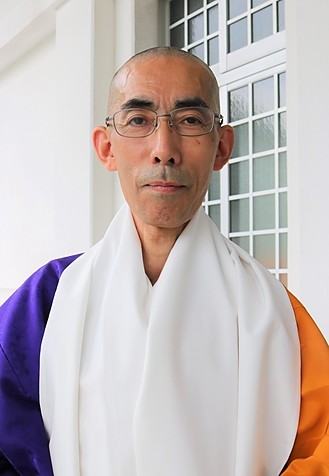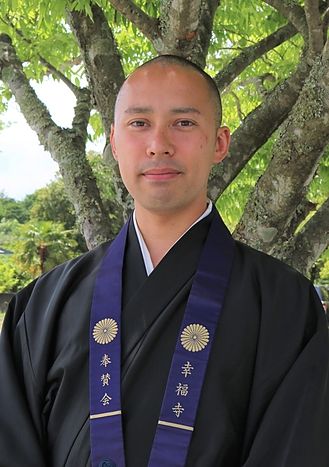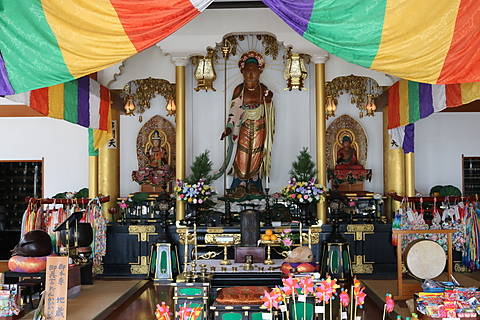Latest Announcements
2023年8月5日 : Latest Dharma Talk [July Reiwa] Memorial
2023年8月5日 : Request for donation of renovation of "grave visit rest area"
 history
history
幸福寺が建つ「大仏山」は玉城・明和・小俣に跨る標高50メートル程の山で、古代より大仏山周辺を生活拠点として人々は生活をしていました。
Around this mountain, there is a place called Jugamura of Aruigo, where a group of craftsmen lived who burned earthenware used for Jingu rituals while farming. Since the Jingu (Inner Temple) was established in the land of Ise, earthenware made in these villages has been prepared, and clay, which is the raw material for earthenware, was collected at a clean soil collection site in Seko (Seko Village), where it was located at that time.
In the Middle Ages, it is said that "Shunjobo Shigegen Jojin" visited Ise Jingu Shrine to rebuild the Great Buddha Hall of Todaiji Temple, which was burned down in the Genpei War, and at that time, he stayed on Daibutsuzan and made a template (small statue) of the Great Buddha statue.
The singing monk "Yaoko" recounted the legend of the Jūgen Shangjin in the 5th year of Eikyo (1433), calling the Great Buddha Mountain the Earth Buddha,
This mountain is my height, and I wonder if you will look up to me again.
It is written in "Ise Travelogue".
This song praises the Great Buddha Mountain as the Pure Land (Sacred Mountain Pure Land) where Buddha, the founder of Buddhism, preached. Against the background of the legend of the Shigegen Shangjin and the teaching that the Buddha preached in the Kegon Sutra is an incarnation of the Great Buddha of Nara, it is thought that he compared the Great Buddha Mountain to Mt. Reiwashi and sang that it was the Pure Land preached by Buddha (Biroku Shielding Buddha).
The first chief priest of the temple sought a place of memorial service according to his will and treated him to the Great Buddha Mountain in the spiritual district. Then, in Showa 57, the main hall was decommissioned, and the "Great Buddha Mountain Happiness Temple" was opened.
Since it is closely related to the Ise Jingu Shrine and was opened to a land where the faith of the Shigegen people can be seen, the current Happiness Temple respects and worships both Shinto and Buddhism. And against the backdrop of these histories, we strive to make it a place where everyone can visit in peace.
Around this mountain, there is a place called Jugamura of Aruigo, where a group of craftsmen lived who burned earthenware used for Jingu rituals while farming. Since the Jingu (Inner Temple) was established in the land of Ise, earthenware made in these villages has been prepared, and clay, which is the raw material for earthenware, was collected at a clean soil collection site in Seko (Seko Village), where it was located at that time.
In the Middle Ages, it is said that "Shunjobo Shigegen Jojin" visited Ise Jingu Shrine to rebuild the Great Buddha Hall of Todaiji Temple, which was burned down in the Genpei War, and at that time, he stayed on Daibutsuzan and made a template (small statue) of the Great Buddha statue.
The singing monk "Yaoko" recounted the legend of the Jūgen Shangjin in the 5th year of Eikyo (1433), calling the Great Buddha Mountain the Earth Buddha,
This mountain is my height, and I wonder if you will look up to me again.
It is written in "Ise Travelogue".
This song praises the Great Buddha Mountain as the Pure Land (Sacred Mountain Pure Land) where Buddha, the founder of Buddhism, preached. Against the background of the legend of the Shigegen Shangjin and the teaching that the Buddha preached in the Kegon Sutra is an incarnation of the Great Buddha of Nara, it is thought that he compared the Great Buddha Mountain to Mt. Reiwashi and sang that it was the Pure Land preached by Buddha (Biroku Shielding Buddha).
The first chief priest of the temple sought a place of memorial service according to his will and treated him to the Great Buddha Mountain in the spiritual district. Then, in Showa 57, the main hall was decommissioned, and the "Great Buddha Mountain Happiness Temple" was opened.
Since it is closely related to the Ise Jingu Shrine and was opened to a land where the faith of the Shigegen people can be seen, the current Happiness Temple respects and worships both Shinto and Buddhism. And against the backdrop of these histories, we strive to make it a place where everyone can visit in peace.
 Introduction of monks
Introduction of monks

[Chief priest] Nagata Mitsuyama (Tsuzan Agawa)

Deputy Chief Priest: Yoshiyuri Nagata (I want to be a long time old.)
 Happiness temple events calendar
Happiness temple events calendar
Calendar of events monthly
Jizo Buddhist service and sermon

Annual events
3moon
7moon
8moon
9moon
12moon
 Happiness Temple newsletter
Happiness Temple newsletter







